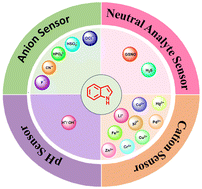Small-molecule fluorogenic probes based on indole scaffold
Abstract
Indoles are the most versatile organic N-heterocyclic compounds widely present in bioactive natural products and used in different fields such as coordination chemistry, pharmacy, dyes, and medicine, as well as in the biology and polymer industries. More recently, the indole scaffold has been widely used in analytical chemistry for the design and development of small-molecule fluorescent chemosensors in the fields of molecular recognition and molecular imaging. The indole-based chemosensor derivatives contain heteroatoms like N-, O-, and S-, through which they interact with analytes (cations, anions, and neutral species), producing measurable analytical signals that can be used for the fluorimetric and colorimetric detection of different analytes in biological, agricultural and environmental samples. This review focuses on indole-based small-molecule fluorimetric and colorimetric chemosensors for detecting cations, anions, and neutral species in a comprehensive manner. Furthermore, the recognition mechanisms are discussed in detail, which could help researchers design and develop more powerful and efficient fluorescent chemosensors in the near future.



 Please wait while we load your content...
Please wait while we load your content...